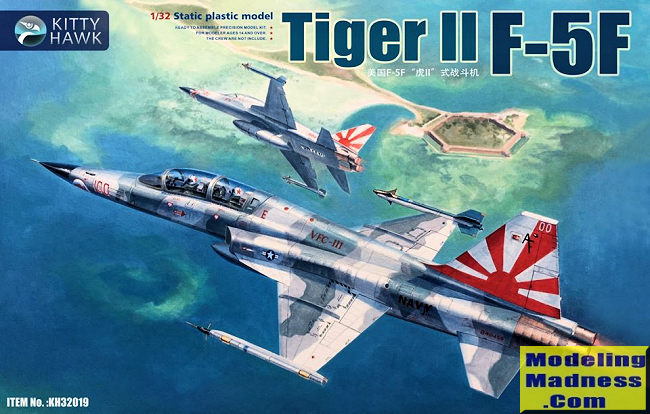
| KIT #: | KH 32019 |
| PRICE: | $60-70 street price |
| DECALS: | Seven options |
| REVIEWER: | Scott Van Aken |
| NOTES: | 2018 tooling |

| HISTORY |
The F-5E and F-5F Tiger II are part of a supersonic light fighter family, initially designed in the late 1950s by Northrop Corporation. Being smaller and simpler than contemporaries such as the McDonnell Douglas F-4 Phantom II, the F-5 cost less to both procure and operate, making it a popular export aircraft. The F-5 started life as a privately funded light fighter program by Northrop in the 1950s. The design team wrapped a small, highly aerodynamic fighter around two compact and high-thrust General Electric J85 engines, focusing on performance and low cost of maintenance. Though primarily designed for the day air superiority role, the aircraft is also a capable ground-attack platform. The F-5A entered service in the early 1960s. During the Cold War, over 800 were produced through 1972 for U.S. allies. Though the USAF had no acknowledged need for a light fighter, it did procure roughly 1,200 Northrop T-38 Talon trainer aircraft, which were directly based on the F-5A.
After winning the International Fighter Aircraft competition in 1970, a program aimed at providing effective low-cost fighters to American allies, Northrop introduced the second-generation F-5E Tiger II in 1972. This upgrade included more powerful engines, higher fuel capacity, greater wing area and improved leading edge extensions for a better turn rate, optional air-to-air refueling, and improved avionics including air-to-air radar. Primarily used by American allies, it remains in US service to support training exercises. It has served in a wide array of roles, being able to perform both air and ground attack duties; the type was used extensively in the Vietnam War. A total of 1,400 Tiger IIs were built before production ended in 1987. More than 3,800 F-5 and the closely related T-38 advanced trainer aircraft were produced in Hawthorne, California. The F-5N/F variants are in service with the United States Navy and United States Marine Corps as an adversary trainer. Approximately 500 aircraft are in service as of 2014.
| THE KIT |
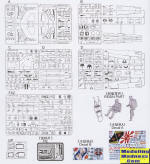 Like all of Kitty Hawk's kits, I'm impressed with the amount of
detail and the sheer number of parts in this one. Now let me preface all
this by stating that I do not read other reviews of kits, preferring to go
into them without any preconceived notions.
Like all of Kitty Hawk's kits, I'm impressed with the amount of
detail and the sheer number of parts in this one. Now let me preface all
this by stating that I do not read other reviews of kits, preferring to go
into them without any preconceived notions.
It was obvious after looking at their
F-5E kit that Kitty Hawk was going to do an F-5F version and I'm so
glad they did as the two seat F-5F is a version that has never been kitted
by a major manufacturer in this scale before. Not surprisingly, the major
difference between this and the F-5E kit is the forward fuselage. The
cockpit is superbly detailed, providing basically the F-5E cockpit with a
separate 'pit for the tw o
seat version. The sprue that has changed is pretty much for this area. KH
got the gun bay right in that there is only one on the F. The seat is a goodly number of parts,
however, they missed the fact that with two seats you need two harnesses and
the p.e. fret only has one. They did get the canopy and surround etched bits
correct. It appears that the canopy
mechanism is molded in the open position though those who want to close this
should not have any issues. A tendency in modern kits is to provide
everything open and while that is great for those who like that, it can be
difficult to model things shut. I've not found this to be much of an issue
with KH kits.
o
seat version. The sprue that has changed is pretty much for this area. KH
got the gun bay right in that there is only one on the F. The seat is a goodly number of parts,
however, they missed the fact that with two seats you need two harnesses and
the p.e. fret only has one. They did get the canopy and surround etched bits
correct. It appears that the canopy
mechanism is molded in the open position though those who want to close this
should not have any issues. A tendency in modern kits is to provide
everything open and while that is great for those who like that, it can be
difficult to model things shut. I've not found this to be much of an issue
with KH kits.
Once the nose gear well is built, KH wants you to install the nose gear. I'd do some dry fitting to see if this can be left until later. There is a radar antenna, which I'm sure most will leave off. I looked through the sprues and only saw the sharknose radome. This may negate some of the markings options of those planes were not upgraded. You will need to do your research on the sharknose as the wing lerex is the later version and will have to be trimmed back for the earlier planes. There is more p.e. for the canopy frame and the gun bay locks. These are also designed the be open.
With the nose done, you move on to the rest of the fuselage and wings. The engines are built up along with the main gear wells and the main gear. Note that the tires are all flat on the bottom. The wells are then put into the flatish lower fuselage and the upper section added. At this time, the nose section is installed along with the intakes (more p.e. on these), engine blow in doors (open or closed) and the exhaust with resin burner cans.
Upper and lower wing halves are assembled and the landing gear with doors are installed. Ailerons, flaps and slats are separate. The fin also has a separate rudder, all of these being molded in the neutral position. Once the flight surfaces are installed on the fuselage, a myriad of antennas and sensors as well as the nose doors, inner main doors and the speed brakes (posed open) are installed. The kit includes the chaff/flare dispenser used on the later planes so check your references to see if your model will need this feature.
There are four wing pylons, wing tip racks, and a centerline pylon. For things to put on them are two styles of Sidewinders, a pair of Rockeyes or Mk,84 iron bombs, a pair of Sparrows, and three fuel tanks. The kit also includes a resin boarding ladder as well as a seated and standing pilot.
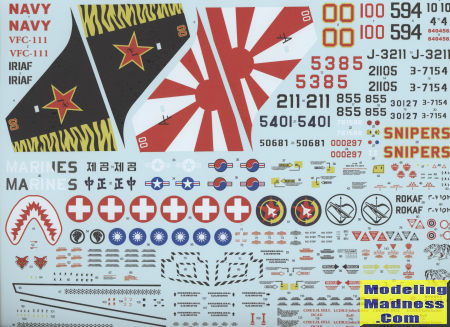
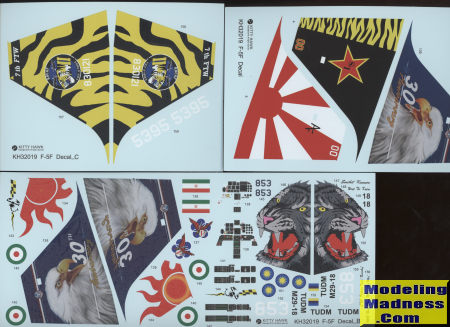
Instructions are typical and there are no fewer than twelve options, none of which are identified as to unit or nation. The painting and markings sheets are done in grey scale on this kit where they used to be color. I'm also wondering if KH expects you to remove the staples from the instructions to pull out the option sheet you want to use as once again, except for the center, one page has half of one option and half of another. The options are very international. One South Korean, one Swiss, three from Taiwan, two from Singapore, one from VFC-111, one from Malaysia, one from VMT-401, and one from Iran. I think that covers them all. Many of these have special schemes. The decal sheet is nicely done, but there are some glitches, most of which were corrected by adding an additional sheet. Except for the mirror printing on one side of the VMT-401 tail marking. Only one 'fixed' side was printed. My experience with KH decals is that they are exceptionally thin so care is needed. A full stencil suite is provided.
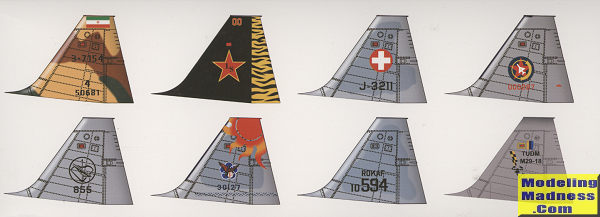
| CONCLUSIONS |
It is obvious to me that Kitty Hawk researched the fully modified F-5Ns operating out of Key West for this kit as there are features that simply were not present on earlier planes. The builder will have to do some additional research on most of these schemes to see just what bits were there or changed. A look at the photos in the reference will be sufficient to get the lerex shape right for early planes. It will be just a few minutes with a sanding stick to fix. The radome for earlier planes will need to come from another source.
This is a very nicely done kit that has a lot more detail in it that the significantly older Hasegawa kit. Care in construction will result in an excellent model. I've built Kitty Hawk kits and they do take some patience to build. Not for the beginner, but an intermediate or advanced modeler will have no difficulties. I'd recommend picking one up if you are a fan of the type.
| REFERENCES |
https://en.wikipedia.org/wiki/Northrop_F-5
November 2018
Thanks to Glen Coleman and Kitty Hawk
for the preview kit. You can find this kit at your favorite hobby shop
or on-line retailer.
If you would like your product reviewed fairly and fairly quickly, please
contact the editor or see other details in the
Note to
Contributors. Back to the Main Page
Back to the Review Index Page
Back to the Previews Index Page